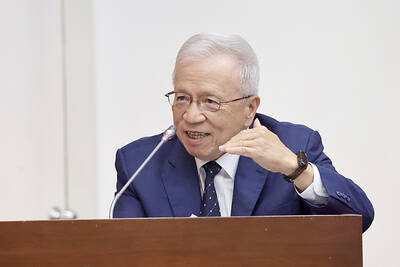Exports last month slumped 13.1 percent year-on-year to a 19-month low of US$36.13 billion, as demand for all product categories dwindled in almost all markets, especially in China, the Ministry of Finance said yesterday.
The decline was the fastest in seven years, with China contributing 66 percent, as escalating COVID-19 infections weighed on sales of smartphones and other consumer electronics, the ministry said.
“The retreat this quarter turned out worse than expected and might far miss the recent forecast by the Directorate-General of Budget, Accounting and Statistics,” Department of Statistics Director-General Beatrice Tsai (蔡美娜) said.

Photo: CNA
The agency is looking at a 3.9 percent fall in exports this quarter, but the actual decline would double to 7 percent, Tsai said, adding that tepid sales spread to high-tech sectors without signs of improvement any time soon.
Persistent inflation and drastic monetary tightening, as well as China’s strict COVD-19 restrictions, dashed hopes of a business rebound boosted by Double 11 Singles’ Day in China and Christmas sales in the West, she said.
That explained why Apple Inc had slashed its iPhone sales forecast for this year, Tsai added.
Exports this month might tumble 8 to 12 percent, she said.
Shipments of electronic components shrank 4.9 percent, with chip sales falling 3.4 percent, ending nearly three years of expansions, the ministry’s monthly report showed.
Exports of optical devices, mainly flat panels and camera lenses, remained the weakest, with a 31.9 percent decrease from a year earlier, Tsai said, adding that smartphone camera lens supplier Largan Precision Co (大立光) expects lackluster business for this month.
Exports to China, including Hong Kong, plunged 20.9 percent, erasing gains in the first 10 months of this year, and might further decline this month, Tsai said.
Shipments to other destinations were similarly soft, with an 11.3 percent decrease to the US, a 19 percent drop to Europe and a 4.5 percent retreat to Southeast Asia, she said.
Japan proved the exception with a 15 percent gain, thanks to robust demand for electronics, the report said.
A weak New Taiwan dollar against the US dollar also weighed on exports, Tsai said.
Imports fell 8.6 percent to US$32.7 billion, giving Taiwan a trade surplus of US$3.43 billion, down 40.6 percent from a year earlier, the ministry said.
Imports of agricultural and industrial raw materials shed 15.3 percent, as local firms cut capacity to cope with a business slowdown and facilitate inventory adjustments, it said.
Imports of capital equipment held strong with an 11.7 percent pickup, as semiconductor firms pressed ahead with technology upgrades, it said.
In the first 11 months, exports expanded 9.4 percent to US$443.78 billion, while imports advanced 14.3 percent to US$396.63 billion, it said.
Exports are expected to set a record for the full year, but the outlook for the next couple of months is bleak, Tsai said.

JITTERS: Nexperia has a 20 percent market share for chips powering simpler features such as window controls, and changing supply chains could take years European carmakers are looking into ways to scratch components made with parts from China, spooked by deepening geopolitical spats playing out through chipmaker Nexperia BV and Beijing’s export controls on rare earths. To protect operations from trade ructions, several automakers are pushing major suppliers to find permanent alternatives to Chinese semiconductors, people familiar with the matter said. The industry is considering broader changes to its supply chain to adapt to shifting geopolitics, Europe’s main suppliers lobby CLEPA head Matthias Zink said. “We had some indications already — questions like: ‘How can you supply me without this dependency on China?’” Zink, who also

At least US$50 million for the freedom of an Emirati sheikh: That is the king’s ransom paid two weeks ago to militants linked to al-Qaeda who are pushing to topple the Malian government and impose Islamic law. Alongside a crippling fuel blockade, the Group for the Support of Islam and Muslims (JNIM) has made kidnapping wealthy foreigners for a ransom a pillar of its strategy of “economic jihad.” Its goal: Oust the junta, which has struggled to contain Mali’s decade-long insurgency since taking power following back-to-back coups in 2020 and 2021, by scaring away investors and paralyzing the west African country’s economy.

BUST FEARS: While a KMT legislator asked if an AI bubble could affect Taiwan, the DGBAS minister said the sector appears on track to continue growing The local property market has cooled down moderately following a series of credit control measures designed to contain speculation, the central bank said yesterday, while remaining tight-lipped about potential rule relaxations. Lawmakers in a meeting of the legislature’s Finance Committee voiced concerns to central bank officials that the credit control measures have adversely affected the government’s tax income and small and medium-sized property developers, with limited positive effects. Housing prices have been climbing since 2016, even when the central bank imposed its first set of control measures in 2020, Chinese Nationalist Party (KMT) Legislator Lo Ting-wei (羅廷瑋) said. “Since the second half of

Taiwan Semiconductor Manufacturing Co (TSMC, 台積電) received about NT$147 billion (US$4.71 billion) in subsidies from the US, Japanese, German and Chinese governments over the past two years for its global expansion. Financial data compiled by the world’s largest contract chipmaker showed the company secured NT$4.77 billion in subsidies from the governments in the third quarter, bringing the total for the first three quarters of the year to about NT$71.9 billion. Along with the NT$75.16 billion in financial aid TSMC received last year, the chipmaker obtained NT$147 billion in subsidies in almost two years, the data showed. The subsidies received by its subsidiaries —